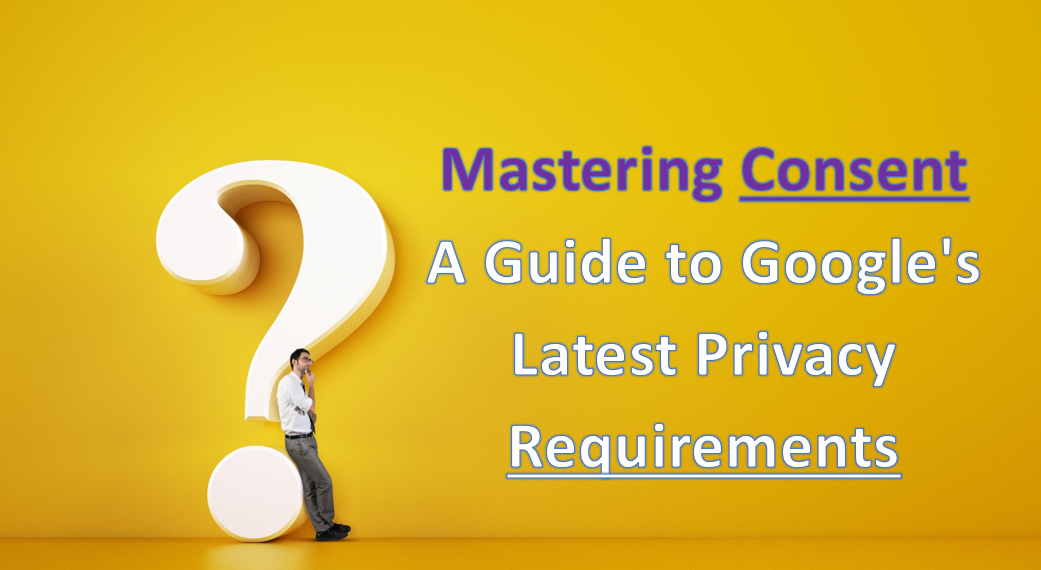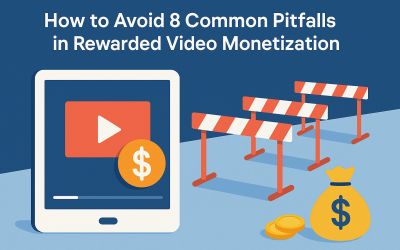In past blogs, I have extensively covered Online Privacy and Privacy related changes that are affecting Ad Monetization. In this blog post, “Mastering Consent: A Guide to Google’s Latest Privacy Requirements”, I will talk about Google’s User Consent Requirements. I have listed some of the posts where we discussed Privacy in a rahter detailed manner.
https://blog.applixir.com/blog/online-privacy-an-obstacle-or-an-opportunity-to-monetization/
As always, I have the table of content below so you can easily follow or jump to your topic of interest.
[ez-toc]
Contents
- 1 Industry Transformation: Google’s Latest Privacy Requirements
- 2 Google’s New User Consent Requirements:
- 3 Implementation Timeline for TCF 2.2:
- 4 Challenges and Publisher Response: Mastering Consent
- 5 Consent Management Platforms (CMPs):
- 6 CMP Implementation Considerations: Google’s Privacy Requirements
- 7 Importance for Publishers:
Industry Transformation: Google’s Latest Privacy Requirements
The mobile game industry has undergone significant transformation in recent years, driven by a combination of technological advancements, regulatory changes, and evolving user expectations. One major aspect of this transformation has been the increased focus on user privacy and data protection, exemplified by the introduction of the IDFA (Identifier for Advertisers) changes by Apple and similar movements by other tech giants. This shift towards greater privacy has compelled game developers and publishers to rethink their strategies around ad targeting and monetization, as the traditional methods of collecting user data have become more regulated and restricted.
Game publishers are therefore finding themselves in a position where they must adapt quickly to these evolving dynamics, leveraging new tools and strategies like Consent Management Platforms (CMPs) to comply with regulations like the GDPR and TCF 2.2, while still aiming to provide engaging user experiences and sustain their monetization models.
Google’s New User Consent Requirements:
Contiuning my post on Mastering Consent: A Guide to Google’s Latest Privacy Requirements, as of May 16, 2023, Google has mandated the collection of user consent for its advertising services like AdMob, AdManager, and AdSense through a Google-certified Consent Management Platform (CMP). This directive is part of a broader initiative to comply with the Transparency & Consent Framework (TCF) 2.2, specifically targeting users in the European Economic Area (EEA) and the United Kingdom. This development is a response to increasing regulatory demands for user privacy and data protection, reflecting a global trend towards more stringent data governance.
This change imposes a significant challenge for game publishers, as they must now ensure that their methods of displaying ads are fully compliant with these new requirements. The deadline for alignment with this directive is set for January 16, 2024, giving publishers a limited window to adapt. The process involves not just technical integration, but also a strategic reevaluation of how user consent is obtained and managed. Publishers now face the task of choosing an appropriate CMP from a list of Google-approved platforms, which involves considerations such as support availability, customization options, and compliance with various international data protection regulations. This change underscores a larger movement within the industry towards more transparent and user-consent-driven advertising practices, fundamentally altering how game developers and publishers approach ad monetization and user data.
Implementation Timeline for TCF 2.2:
Transparency & Consent Framework (TCF 2.2) is a set of guidelines formulated by the Interactive Advertising Bureau (IAB) to enhance user privacy and consent transparency, particularly within the European Economic Area (EEA) and the United Kingdom. Google, as a major player in the digital advertising space, announced on May 16, 2023, that publishers using its advertising services like AdMob, AdManager, and AdSense will need to collect user consent in a manner compliant with TCF 2.2. Publishers have been given a deadline until January 16, 2024, to align with these new requirements. This timeline highlights the urgency with which publishers must adapt to these regulatory changes.
The process of implementing TCF 2.2 is complex, involving the integration of a Google-certified Consent Management Platform (CMP) and adapting to the specificities of the new framework. The transition period until January 2024 signifies a crucial phase for publishers to understand and conform to the new standards, necessitating a reevaluation of their current consent collection processes. This change is not just a technical adjustment but also requires a strategic approach to ensure that user consent is obtained in a manner that is both compliant and user-friendly. The impending deadline has significant implications for publishers, especially considering the potential hesitancy to make major changes during the profitable fourth quarter of the year. This scenario echoes previous industry shifts such as the introduction of the GDPR, Apple’s ATT, and Apple Privacy updates, where publishers often delayed adoption until the last moment, demonstrating a pattern of response to regulatory changes in the digital advertising landscape.
Challenges and Publisher Response: Mastering Consent
One of the primary challenges I want to mention in Mastering Consent: A Guide to Google’s Latest Privacy Requirements post is technical integration and compliance with these new standards. Publishers must implement a Google-approved Consent Management Platform (CMP), which necessitates changes to their existing systems and workflows. This is not a trivial task, as it requires both time and resources, and in some cases, a substantial overhaul of how user data is handled, and consent is obtained.

Moreover, the publisher’s response to these changes has been varied. While some have proactively begun the process of aligning their operations with TCF 2.2, others are more hesitant, often due to the costs involved, the complexity of the task, or uncertainty about the best approach to take. There’s also a concern about how these changes might impact user experience and, consequently, the revenue streams of publishers. Balancing compliance with maintaining user engagement and monetization remains a critical challenge. The industry has seen similar scenarios with previous major regulatory shifts, like the introduction of GDPR, where many publishers scrambled to comply at the last minute. This historical context suggests a pattern in the industry’s response to such regulatory changes, highlighting a mix of proactive adaptation and cautious observation before committing to significant overhauls.
Consent Management Platforms (CMPs):
CMPs are software solutions that enable websites to manage and document the consent of their users, especially in relation to the use of personal data for advertising and other purposes. With the increasing emphasis on user privacy and data protection laws like GDPR and CCPA, CMPs have become essential tools for publishers to ensure they adhere to legal requirements while still being able to monetize their content effectively.
Implementing a CMP involves several critical decisions for publishers. Firstly, they need to choose a CMP that is recognized and approved by Google, which ensures compatibility with Google’s advertising ecosystem. This decision is crucial since Google’s advertising services are a significant source of revenue for many publishers. Secondly, the CMP must be configured correctly to capture user consent in a manner that is compliant with TCF 2.2 and other relevant regulations. This means not only presenting users with clear and comprehensive options regarding their data but also ensuring that this consent is verifiable and can be passed correctly to ad tech partners. The challenge here lies in balancing the legal requirements with a user-friendly experience, as overly intrusive or complex consent mechanisms can deter users and potentially impact site traffic and engagement negatively. As such, CMPs are at the forefront of how publishers navigate the evolving landscape of digital advertising and user privacy.
CMP Implementation Considerations: Google’s Privacy Requirements
This implementation is a delicate balance, requiring careful planning and strategic decision-making to ensure compliance with privacy regulations like TCF 2.2 and Google’s user consent policies, while also maintaining a positive user experience. One major consideration is the selection of the right CMP, which involves evaluating whether the platform is compatible with the publisher’s existing digital ecosystem, including ad servers and data management systems. The chosen CMP must seamlessly integrate with these systems to ensure that user consent preferences are accurately communicated and respected across all data processing activities.
Another crucial aspect is the customization and configuration of the CMP. Publishers must tailor the consent interface to be clear, user-friendly, and reflective of their brand. This includes deciding how consent options are presented, ensuring they are easy to understand and navigate. The aim is to obtain valid and informed consent without causing friction in the user experience. Additionally, publishers need to stay updated with evolving legal requirements and adapt their CMP settings accordingly. This means regularly revising the language used in consent forms, the categorization of data collection purposes, and the transparency of information provided to users. The implementation of a CMP is not a one-time activity but a continuous process of optimization and compliance, highlighting its importance in the dynamic and regulation-intensive world of online publishing and advertising.
Importance for Publishers:
 In an era marked by stringent data privacy laws and increasing public concern over data usage, publishers face the dual challenge of complying with regulations like GDPR and TCF 2.2 while striving to provide personalized content and ads that drive revenue. Effective consent management not only helps in adhering to these regulations but also builds trust with the audience. When users feel confident that their privacy preferences are respected, they are more likely to engage positively with the website and its content. This trust is crucial for publishers, as it can lead to increased readership loyalty and better engagement metrics, which are vital for attracting advertisers and monetizing content.
In an era marked by stringent data privacy laws and increasing public concern over data usage, publishers face the dual challenge of complying with regulations like GDPR and TCF 2.2 while striving to provide personalized content and ads that drive revenue. Effective consent management not only helps in adhering to these regulations but also builds trust with the audience. When users feel confident that their privacy preferences are respected, they are more likely to engage positively with the website and its content. This trust is crucial for publishers, as it can lead to increased readership loyalty and better engagement metrics, which are vital for attracting advertisers and monetizing content.
AppLixir is a leading Rewarded Video Ad & Monetization Platform! AppLixir can help ensure that video ads are served in compliance with user consent preferences. This is especially important given the interactive and often data-intensive nature of video ads.
We can offer publishers the tools to deliver targeted and effective video advertising while remaining within the boundaries of user consent. This ensures a balance between monetization and compliance, allowing publishers to maximize their ad revenue without infringing on user privacy.



